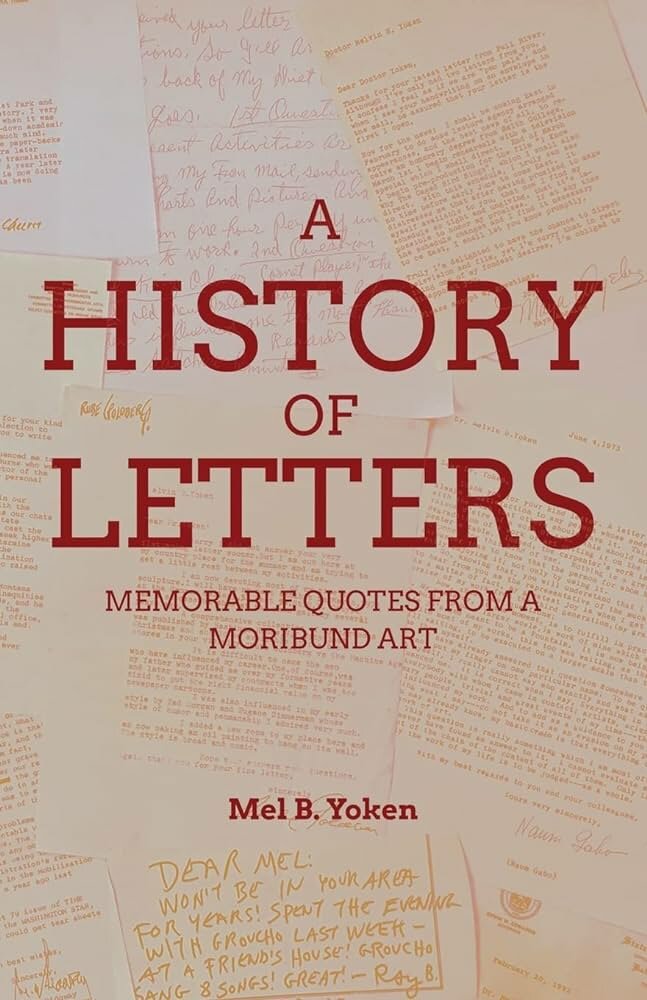Mel B. Yoken’s letters
Have you ever met a belletrist? Yes, I mean a writer of belles lettres.
These are English words derived from French. Since about 1710, according to the latest edition of Merriam-Webster’s Collegiate Dictionary (2020), belles lettres have represented a genre of literature “that is an end in itself and not merely informative.” Indeed, such letters can be “light, entertaining, and often sophisticated literature.”
In my opinion, they can also be invigorating, if not downright fun.
For more than two decades, I have known a belletrist, and he is also the chancellor professor emeritus of French language and literature at the University of Massachusetts, Dartmouth. Far from being a snob, however, Mel B. Yoken is a humble person – actually a mensch (a word probably not derived from French). I also know that Mel is a stalwart of Congregation Tifereth Israel, near his home in New Bedford.
While growing up in Fall River, Mel was surely instructed by his parents to write thank-you notes for birthday and Hanukkah gifts. Perhaps he gained momentum as a letter writer when he went to summer camp.
After learning to type, his inclinations may have turned into a hobby. But by his early twenties, Mel’s passion had morphed into an obsession – perhaps even a way of life.
Beginning in 1963, Mel wrote numerous letters per day, or thousands per year. And most of these were not sent to his dear relatives, friends or colleagues. Rather, he sought to strike up conversations with people whom he had never met, and probably would never meet. These were mostly people whom he admired and wished to compliment, or simply ask a few questions.
Such literati and glitterati included novelists, poets, playwrights, critics, composers, musicians, actors, comedians, directors, painters, sculptors, cartoonists, architects, governors, senators, presidents, diplomats, civil rights leaders, historians, philosophers, scientists, university presidents, astronauts and athletes. Some Nobel Prize winners too.
What, you didn’t receive a letter?
Mel wrote primarily to Americans, but also to Europeans (occasionally in French). He also addressed a smattering of world leaders, such as Moshe Dayan and Indira Gandhi. While perceiving Jewish thought in the broadest terms, he also wrote to some quite distinguished rabbis, such as Mordecai Kaplan, Harold Kushner and Jacob Rader Marcus.
It’s amazing how many of these highly accomplished people wrote back to Mel – and that so many expressed gratitude for being contacted, and asked him, in turn, some thoughtful questions. How remarkable that many of Mel’s correspondents were inspired to establish a continuing dialogue!
But who was the more honored or delighted correspondent – Mel for receiving gracious and stimulating replies, or the recipients of his letters, who also felt deeply rewarded?
Mel and I may be distant cousins, for I too have sought a wide circle of acquaintances, through extensive oral-history interviews. Initially focused on the visual arts, I interviewed painters, sculptors, collectors and museum directors. Later, curious about architects, I interviewed such luminaries as Richard Meier, I.M. Pei, Kevin Roche, Paul Rudolph, Moshe Safdie and Robert A. M. Stern. In my own backyard, I have also recorded extensive conversations with Temple Beth-El’s rabbinic and lay leaders.
Mel, my friend and colleague, has donated tens of thousands of letters to Brown University’s Hay Library, which established the Yoken Room on its third floor. He also established an annual speakers’ program at the Hay, where many of his favorite authors have been invited to address students, professors, alumni and other bibliophiles.
Atmosphere Press, of Austin, Texas, has published two collections of some of Mel’s favorite missives, which he titled, “A History of Letters: Memorable Quotes from a Moribund Art.” The first volume appeared in 2022, and the second a year later, and each is about 150 pages. The books can be purchased online through Barnes & Noble or Amazon for $25 each in hardback or for $20 each in paperback editions.
Begun during the early 1960s, Mel’s letters are organized alphabetically by authors. There are 86 authors in the first volume, 90 in the second. As if to downplay his own importance, Mel’s books consist almost entirely of replies to his inquiries and overtures.
Here’s a short list of Mel’s correspondents who particularly interest me: Agatha Christie, Milos Forman, Ruth Bader Ginsburg, Rube Goldberg, Walter Gropius, Georges Simenon, Isaac Bashevis Singer, Stephen Sondheim, William Styron and Tom Wolfe. And here are a few correspondents I would have avoided: Bing Crosby, Monty Hall, J. Edgar Hoover, Richard Nixon, Barbara Walters, Caspar Weinberger and William Westmoreland.
So who writes and saves letters today? Who could possibly follow in Mel’s footsteps? Who has the curiosity, persistence and patience?
Perhaps Mel is generous when he refers to belles lettres as merely a “moribund” art. But I hope for a renaissance of handwritten or other personal correspondence that will surprise and delight us.
GEORGE M. GOODWIN, of Providence, is the editor of Rhode Island Jewish Historical Notes.











